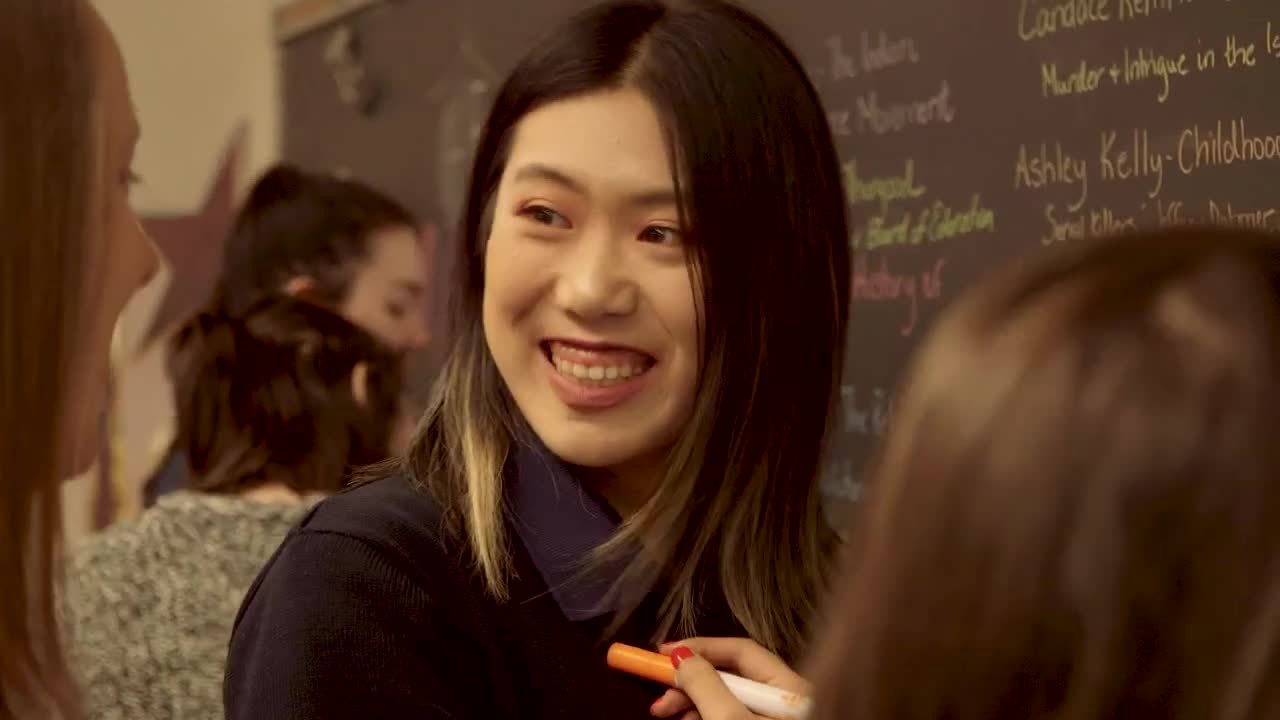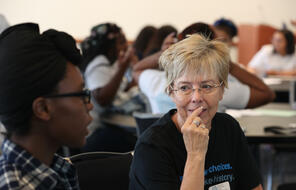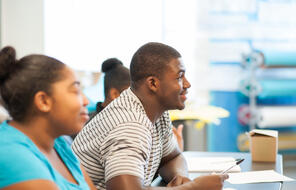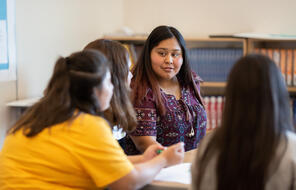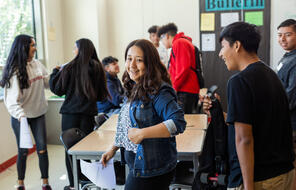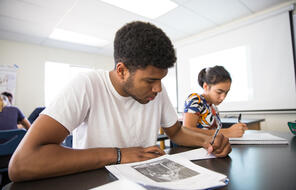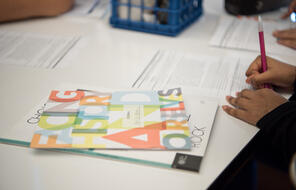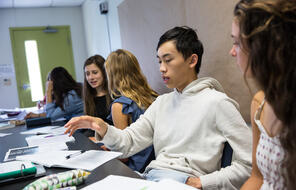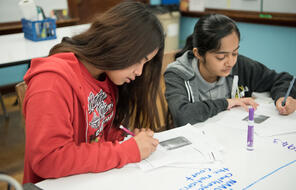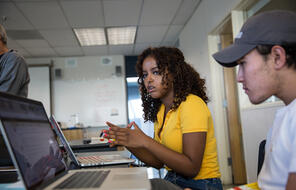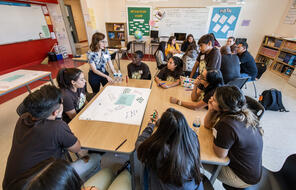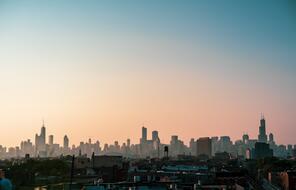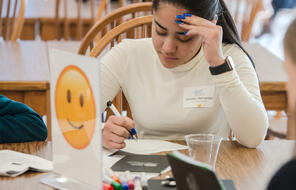The reasoning behind a gallery walk is to allow students who really like to make observations and are good at making observations, but might be a little hesitant to raise their hand in class, to allow them the space and time to write down their observations about pictures around the room. So the general idea of a gallery walk is you have Big Paper. If you don't have that Big Paper, you can also put pictures on chalkboards or whiteboards. And you can also tape computer paper up to it, somewhere where students can write around the picture. And I created the gallery walk, in which you have these pictures of memorials that students can then respond to. A gallery walk can be anything from photographs, to political cartoons, quotes, or pieces of legislation, something visual that they are then commenting on. And what I really love about gallery walks is that as students rotate around the images and the big pieces of paper, they can communicate with one another. And this is a little bit more anonymous. So I know sometimes they're like, I know whose handwriting that is. But they can have a conversation, through writing, about what they see. Students really respond well to it because anyone can look at an image and have a thought. And it allows people to enter into the conversation, I think, in a really unique and creative way. Because they can just make an observation, or they can write a question. It doesn't always have to be this profound, historical statement. But it can be, I have a question about this. And then someone else who is rotating around stops and she thinks, oh, I think I have an answer to that, but I'm going to write it down anyways and see if anyone has any thoughts. And it creates this conversation among students by looking at these visual components as they progress around the gallery, playing off the idea of an art gallery or a museum. One of the things that might be challenging is gallery walk has pictures of the memorials throughout the room. And they may not know the full extent of the history behind that specific event. So for instance, when they see the memorial of General Custer's Last Stand, they may not recall what happened there. But I'm hoping that, through conversations with their classmates, by looking at the design of the memorial, they can deduce, they can use critical thinking skills to come up with ideas as to how that memorial represents what happened, the purpose, the intent, and what it was really trying to convey to those who were going to come and ultimately see the memorial. Have you noticed the big pieces of paper on the wall? Yes? We're going to do something called a gallery walk. I'm assuming you've done this in other classes. I know you've done it with me in 10th grade as well. You're going to take a marker, and I want you to walk around the room. And as you walk around, I want you to write down your thoughts on the big piece of paper surrounding the memorials. Think about purpose, intent of the memorial, try to find out about the location. I did write a few notes underneath each image to give you a sense of where it is and what it's about. Some of them you may not be as familiar with in terms of the historical significance. Feel free to ask me questions, but I'm asking that you grapple with it a little bit based on the context I've given you. And think about the materials and the size. I haven't been to all of these, but I know enough about them where I could give you a little bit more information about what materials were used. But again, try to really think about-- discuss with a neighbor. It doesn't have to be super quiet. If someone's next to you, be like, what is this Native American one made out of, I can't really tell. So feel free to talk to each other as you do it, but make sure you write down thoughts. And as you circulate, should you just go to one poster one time? No, keep circulating. I want you to be able to make comments off of one another. So if you see something really interesting, make a comment off of that. Ask questions through writing. We'll come back together afterwards and have a bit of discussion before we transition into the action project. Questions? All right, so come up, take a color, start making your way around the room. Try to spread out. There's about seven posters. [INDISTINCT CONVERSATION] So in that sense, what do you think this memorial is for? The loss of land, maybe the genocide, the way that the people were pillaged and raped. The Trail of Tears? This is-- After that? --slightly-- uh, yeah, the Trail of Tears is in 1830. So we're a fair amount of time after the Trail of Tears. But you're on the right idea here. I want you to all finish up whatever thought you're writing down. And before you sit down, what I want you to do is just take a moment to walk around the room and read all the comments. And once you've done that, then take a seat. Just a couple more minutes to read other people's comments and have a seat. I was walking around the room, and your comments were phenomenal. And hopefully-- I know Caroline mentioned that one of the ones, the Irish Famine one, was what you did for your Holocaust project. So I want to keep everything in mind that you just wrote on, and I want to discuss a couple of these questions. So think back to the Holocaust and Human Behavior. And when we studied memorials, I had you all go to memorials around the Boston area and do a project on them. Thinking about all the comments you just wrote down, comments that you read, I want you to turn to your partners and think about these three questions in relation to the project you did before, so your project. What influenced your memorial designs? What did you attempt to convey in your memorials? And what was the purpose of your monument? So turn to your partner, discuss those three questions. [SIDE CONVERSATIONS] First of all, I wanted to make the message clear so that there wasn't any confusion on what my memorial was about. And it was also meant to honor the people. I think I also put in scriptures of the Torah. I visited one that was a combination of World War II, Vietnam, any war that, any of the vets from my city had fought in. And they had put their names on, but they had also amazing designs and sculptures to honor the people. But I think the emotion that they want to convey is the loss and the grief that the people have went through. I think the lesson went really well. Students were very engaged in the material. A lot of the comments on the gallery walk were so profound, and I think, got me thinking, and were observations that when I originally looked at these, I thought, oh, I didn't even see that at first. So to see their perspective from all these different voices, I was really just pleasantly surprised, as always, that they exceed my expectations. Facing History, for me, has always provided a space to enter the conversation. Because Facing History and Ourselves provides these tools for educators and for students to talk about very difficult material.
